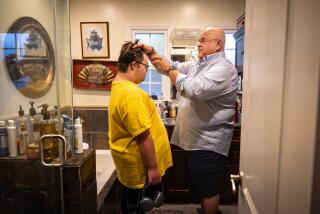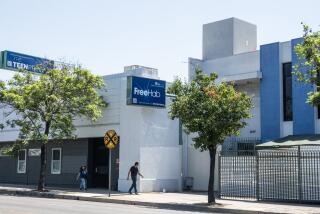Cramped Quarters Prevent Center From Serving Troubled Families
Dorothy Courtney embraces an armload of paperwork and vacates the cubbyhole office she shares with a co-worker at the Richstone Family Center, an outpatient counseling facility in Hawthorne for abused children and their families.
Despite her position as Richstone’s executive director, Courtney regularly is forced to retreat from the comfort of her desk, files and telephone so her office mate, a counselor, can hold therapy sessions with clients.
“Mostly I’m out in the halls,” Courtney says with a laugh. Actually, she often finds a temporary haven in a vacant counseling office. Failing that, she turns to the children’s playroom, which, for all its shortcomings as an executive’s base of operations, at least has a telephone.
Courtney recently moved one step closer to having an office of her own when the Hawthorne City Council approved Richstone’s plans to build a spacious two-story facility next to its present site on Cordary Avenue.
The council action came as especially good news to the center’s staff because the elbow-to-elbow confines have been squeezing out more than just the boss.
Richstone is forced to turn away more than 50 families a year, Courtney says. The center’s current caseload is five times higher than it was 10 years ago, but there’s not enough room to expand the staff. The center now handles more than 300 cases a year, compared to 60 in 1981.
“There’s one more family a week that should be here, but we can’t fit them in,” Courtney says.
The new office would nearly double Richstone’s capacity. Designed by architect Kate Diamond, the 12,500-square-foot center would have 10 counseling rooms, three group rooms, a library/study area, a large play area and on-site parking for the families, staff and volunteers.
The group has raised all but about $600,000 needed for the $1.9-million structure, and if all goes as planned, the new facility would be ready to use by October, 1992.
The nonprofit Richstone Center started in 1973 in a garage behind the Hawthorne YMCA. It moved to its present site in 1979 after converting a modest four-bedroom house, a barn used to raise chinchillas and a garage into six administrative/counseling offices, two group therapy rooms and a children’s playroom.
Its annual caseload, drawn from referrals by schools, social service agencies and the courts, includes about 300 clients, mainly children and teen-agers who have been physically or sexually abused or neglected.
The center’s service area includes the South Bay and southwest Los Angeles, but nearly half of the clients live in Lennox, from where the center receives a large number of referrals from the school district and Sheriff’s Department station. In addition, three of Richstone’s seven counselors are bilingual and can cater to the area’s numerous Spanish-speaking residents.
About half of the clients at Richstone are children 5 through 14, Courtney says. Adults, mainly parents and guardians of the abused children, make up about 40% of the center’s clients.
In addition to on-site counseling, Richstone sponsors community outreach programs coordinated by three staff employees. The services include a speakers bureau, crisis line and training sessions for teachers and students on child abuse prevention.
Courtney says most of Richstone’s clients are impoverished and live in crowded homes in neighborhoods dominated by gangs and violent crime.
“A lot of these families have no celebrations at all,” she says. “They need a place that’s warm and welcoming. In our current facility, even finding a little private area to play with the children is almost impossible.”
One of the group counseling rooms is in the former living room of the house. It’s furnished with threadbare, mismatched sofas, a bare wood coffee table and an aluminum lawn chair.
“I get upset at how funky we’ve become,” says clinical director Elaine Struhl, a 13-year Richstone veteran who devises treatment programs and oversees counseling services at the center. She calls attention to the holes in the sofa upholstery and the general state of decrepitude overtaking the facility.
“Our clients live in poverty. They live surrounded by ugliness. I would like to see us be an oasis for them,” she says.
Daniel, 10, is a fairly typical case at the center. He lives in a foster home with his 12-year-old sister, but has seven other siblings who were removed from their mother’s care because of physical abuse and neglect.
He visits Richstone three times a week, once for counseling and twice for the center’s after-school program. At home, he’s rarely allowed to play outside because his foster parents live in an area dominated by gang violence. His big dream is for his brothers and sisters to be reunited under his mother’s care. Given his mother’s history of drug abuse and neglect, it’s not likely to happen, Courtney says.
She adds that since he began visiting Richstone regularly, Daniel has sharply improved his grades at school and now has a goal: to become a doctor. Courtney says many of the children who are treated at the center envision only the bleakest of futures. “Many just want to live to see next year, or next week,” she says.
A new facility has been the ambition of the center since 1985, when the owners of the lot next to Richstone offered to sell the site to their neighbors for about half of the going rate, Courtney says.
Even at a 50% discount, the one-acre lot cost $425,000, a sizable chunk of cash for a small agency whose budget relies heavily on private contributions, grants and fund-raising events. It took two years for Richstone to raise the funds and buy the property, taking title in 1987. That was the first half of the task.
The second half, funding the construction of the new $1.9-million facility, is still going on.
Courtney, who has been Richstone’s executive director since 1980, has directed her considerable energies into the fund-raising campaign, which has collected more than $1.3 million so far. She says she spends about half of her 50 weekly hours at the center pursuing major contributors. She has also been helped by about 150 volunteers who have used their contacts in the community to raise a substantial portion of the capital.
Courtney is confident the entire $600,000 needed for construction will be raised in time for a groundbreaking ceremony scheduled for next February.
“We’re close. I think we’re showing that we can do it,” she says.
Courtney says it will be comforting to have her own office after the new facility is built, but that’s not high on her priority list. “I’d work out of my car if I had to,” she says.
More to Read
Sign up for Essential California
The most important California stories and recommendations in your inbox every morning.
You may occasionally receive promotional content from the Los Angeles Times.






